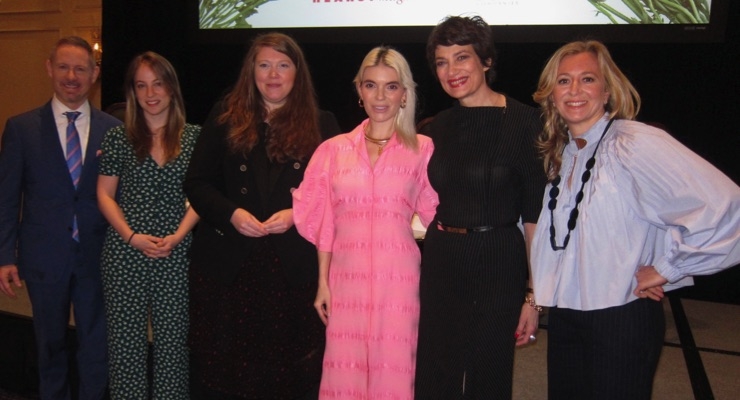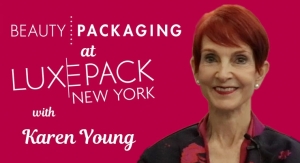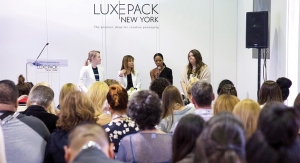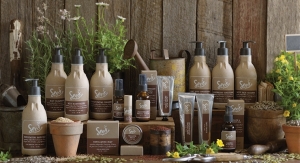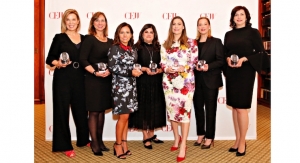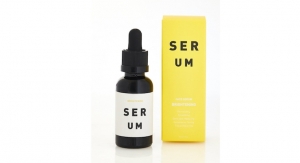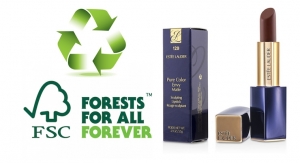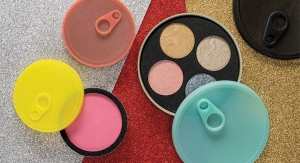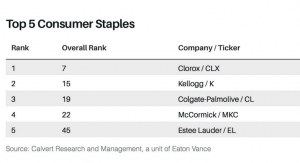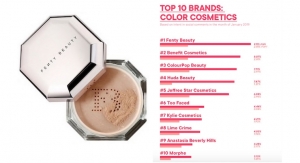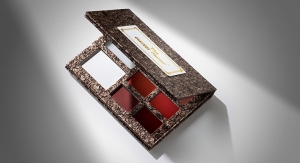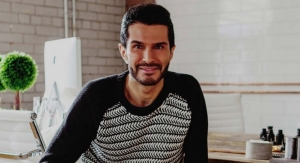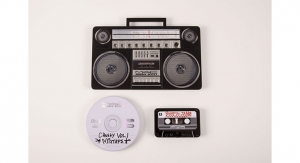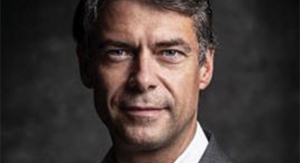05.20.19
If there were any doubts about the value of analytics and marketing data in driving sales, the panelists at Fashion Group International’s (FGI) New Beauty Consumer Symposium laid them to rest. Today’s New Beauty Consumer, the focus of the Symposium held at New York’s Roosevelt Hotel on May 16, 2019, is transforming the business of beauty.
Maryann Grisz, acting manager, FGI, took time to honor the late Margaret Hayes, president, FGI, remarking how she would be missed and how she loved this event. The New Beauty Consumer Symposium included presenter, Carly Cardellino, brand beauty director, Cosmopolitan Magazine, who provided an overview of the beauty industry today; and panelists, Rinat Aruh, co-founder, Aruliden, an agency that creates brands, products and experiences, from strategy to execution; Yarden Horwitz, co-founder, Spate, the Artificial Intelligence Trends Platform for Beauty and Food; Doug Jensen, vice president, Consumer Relationship Management (CRM) and Corporate Marketing Analytics, Estée Lauder Companies; and moderator, Lucie Greene, worldwide director of the Innovation Group at Wunderman Thompson.
Co-Chair of the event, Karen Young said, “We’ve put together an eclectic panel that will inspire provocative thinking for you.” Cosmopolitan’s Cardellino, presented the trend overview, which was followed by a panel discussion; each illuminated the breadth of diversity, ingredient acumen, influencer power, and digital impact that are integral to today’s beauty landscape.
Indie Beauty and Diverse Messaging
Cardellino set her sights on the new consumer, saying, “We are referring to today’s new beauty consumer as Gen Now,” and noted that the beauty industry is changing at the speed of light. “There’s an Indie beauty boom going on right now, and while we all love legacy brands, Indie beauty marketers know how to speak the language of Millennials.”
“Today’s new beauty consumer is discovering products differently, via Instagram, Snapchat, YouTube, print, and Cosmo digital, among others,” she said. “They are more efficient and savvier, and they want to learn about what will work.” Consumers today want to hear testimonials, watch YouTube—and want to be shocked. She advised brands to get on board with these approaches to marketing; and further emphasized the interest among Millennials in skincare and ingredients, as well as the importance of delivering the information they desire to a diverse audience, whether it’s information on hair relaxing, the latest natural styles, or a “life-changing lash lift.”
Delivering the Goods
Panel moderator, Lucie Greene, began with a look at some of the ways in which brands are changing, with authenticity and honesty emerging as key points in the equation. Rinat Aruh, who along with Johan Liden, founded Aruliden, combined their expertise in product design and brand strategy, to pioneer a new approach they called “Producting.” They create experiences across all touch points, independent of the category, and have been retained by such clients as NARS, Google, GigiXHadid, Maybelline, and Bulgari.
Aruh said it was important to really think about what you’re selling and deliver on it. “It’s an activist culture and people will call you out if you don’t deliver. Honesty is key,” she said. Doug Jensen, Estée Lauder Companies, spoke to the diversity of today’s audience, and the growth of the skincare segment. “Skincare is very exciting now and markets continue to grow. The market for skincare in China grew by 30%; and our skincare business in the U.S. has grown 22%,” he said.
“In the U.S., the multi-ethnic consumer is where the growth is,” said Jensen, citing in particular, the Latina and African American skincare market. To reach the new consumer, he said, “Digital is key; and 70% of our current spend is in digital, which reflects a growing change.”
Yarden Horwitz, of Spate, the Artificial Intelligence Trends Platform for Beauty and Food, said, “Today’s consumer is very well read in beauty; and since there is so much access to information, as well as misinformation, there is also a level of stress in finding the right beauty products.” Horwitz, who co-founded Trendspotting at Google, and launched such reports as The Google Fashion Trends Report and The Google Skin Care Trends Report, said that Spate has algorithms for machine learning to gather information about what consumers are looking for in their search for skincare products. “That’s why brands like Pureology are resonating with consumers today, as they are trying to simplify their regimens and product usage,” she said.
Greene noted that anxiousness is driving parts of the market, resulting in an emphasis on stress relief and wellness; as well as a strong technology trend to diagnostic tools. Recognizing the growth of interest in diagnostic tools, Jensen cited the IMatch Perfect Shade Finder for Foundation, as well as the technology that Clinique uses to gather consumer information to provide the best foundation shades for consumers.
“The most exciting thing our team is doing is using AI to figure out what our consumers love or hate about our products. Machine learning and insight gathering is the most important part of finding the key to consumer need,” said Jensen.
The Engagement Perspective
Consumer behavior is both challenging and exciting. “Throughout the entire consumer journey, we’re looking at how people will behave and experience products. From an engagement perspective, it’s something you’re ready to live and breathe,” said Aruh, who emphasized the importance of making sure that conversations continue to happen, both the positive and the negative. “You have to make sure that you get all the perspectives,” said Aruh.
Jensen cited the impact of influencers. “We spend a lot of time looking at brands and watching the influencers. For example, Indie brands were stealing market share because of their influencer engagement. We found that this was an important strategy. In addition, we found authenticity was the most important, and being a consumer advocate is key, which is the strategy we used with La Mer,” he said. Aruh emphasized dialogue with consumers. “Start the dialogue from within, not just the effect of an influencer on Instagram,” she said.
Greene queried how the beauty platform today is influenced, from a social analytic point of view. “Anyone from the Kardashians has an influence,” said Horwitz. “The consumer is very knowledgeable and wants to know what goes into her skin. She is seeking information,” she said. This may come from influencers and celebrities, and other sources. Horwitz cited Reddit as a hub for engagement.
Jensen discussed the specificity of the Indie concept, saying, “I almost think Indie is a U.S. phenomenon. In Asia, there is a great deal of looking at legacy and classic brands. As a company, we invest in quality, which is also what the Asian consumer wants, i.e., authenticity and quality. Some Indie brands may not be sustainable without the quality,” said Jensen.
Aruh observed activity surrounding CBD and its anti-inflammatory properties, saying “Performance is really key. Every other day, we’re seeing another CBD infused product.” Jensen added, “It’s not to say that you can’t have a cannonball ingredient, but it’s important to provide the ingredients that consumers want, and we’re creating a glossary of what ingredients consumers really want in their products.”
“Not every CBD product will yield the result that the consumer is seeking, and ingredient trends evolve. In the past, turmeric was thought to cure everything, however, there are products that promise, but don’t deliver, and then there is backlash,” said Horwitz. She cited such current trends as the jade roller, and new products that are said to create a certain mood.
When asked by Greene if the retail experience was turning into more of a play experience, with an experiential immersion in beauty, Jensen responded in terms of accessibility and reach. “We think about pop-ups when we’re launching something big, like Clinique ID, which we launched in a SoHo pop-up. We all know that the department store experience has changed, and beauty retail has gone to Sephora and Ulta, for example, where consumers have access and exposure to brands,” said Jensen.
Aruh said it comes down to what will make a brand more exciting, adding, “It’s hard work.” Horwitz noted the proliferation of beauty on Amazon and the importance of convenience. “if a consumer wants a product they can just buy it online,” she said. In further discussion of trends in beauty retail, Greene highlighted the concept of “radical inclusivity,” which goes beyond the basics to include body shape, age, diversity, and cosmetics for every gender.
Market Inclusivity and Sustainability
Jensen highlighted the growth of the men’s market, noting, “The male grooming market is currently valued at $63.7 billion, but we believe it’s larger.” He elaborated, “There are brands like Fenty and Morphy that also cater to the Gen Z man,” he said, noting three contributing factors, i.e., the feminization of masculinity, for example, Fluide, non-gender specific fragrance; the Euro man trend; and the brands that are breaking taboos, for example, meeting hair loss needs.
“Younger men already know how to take care of their skin, and among Gen Z men, they are more comfortable using makeup, as well,” said Jensen. “We are in the post-hipster stage now, where you aren’t clubbed over the head with masculine or feminine, but rather a more open perspective,” said Greene. “Consumers are really voting on their feet on everything from packaging to brand access, to sustainability,” she said.
The mandate to achieve better plastics, utilize vendor sharing, and make smart materials choices, is becoming more prevalent, noted Aruh; and the consciousness continues to evolve. “We have cross-cultural teams to figure out which brands are doing good for the world, like the MAC AIDS Fund,” said Jensen. “By 2025, 75-100% of our packaging will be recyclable, refillable, reusable, recycled or recoverable, and we are serious about that commitment,” he said.
“At the end of the day, sustainability is picking up, and certain products, like shampoo bars, that require no packaging, will become more popular. Consumers can see the impact a brand will have on the world, and it will drive consumer behavior,” said Horwitz. Aruh acknowledged the importance of talking about your products in a basic way, saying, “Using the right language is very important when you talk about your brand.”
Using the correct framing will reach specific demographics. Regarding skincare, Jensen said, “Today we hypothesize that the formerly 18-23 year olds, are now moving into the next bracket and are looking into preventive benefit with skincare. Younger women don’t appreciate the framing of ‘anti-aging,’ which impacts older women differently. Younger women will find that language a turn-off and prefer the positioning of taking care of your skin.”
Clearly, the future lies in the relationships consumers develop with brands, and according to Horwitz, the ongoing authentic conversations being conducted with consumers. While data reveals that consumers are driven to be more authentic, that engagement continues to be sought and measured digitally, to determine evolving changes in the market.
—Written by Nancy Jeffries, Correspondent
PHOTO: (L-R): Doug Jensen, VP, Consumer Relationship Management (CRM) & Corporate Marketing Analytics, Estée Lauder Companies; Yarden Horwitz, Co-Founder, Spate, Artificial Intelligence Trend Platforms for Beauty & Food; Lucie Greene, Moderator, Director of the Innovation Group at Wunderman Thompson; Carly Cardellino, Brand Beauty Director, Cosmopolitan Magazine; Maryann Grisz, Acting Manager, Fashion Group International (FGI); and Rinat Aruh, Founder of Aruliden, award winning agency creating brands, products and experiences from strategy to execution.
Maryann Grisz, acting manager, FGI, took time to honor the late Margaret Hayes, president, FGI, remarking how she would be missed and how she loved this event. The New Beauty Consumer Symposium included presenter, Carly Cardellino, brand beauty director, Cosmopolitan Magazine, who provided an overview of the beauty industry today; and panelists, Rinat Aruh, co-founder, Aruliden, an agency that creates brands, products and experiences, from strategy to execution; Yarden Horwitz, co-founder, Spate, the Artificial Intelligence Trends Platform for Beauty and Food; Doug Jensen, vice president, Consumer Relationship Management (CRM) and Corporate Marketing Analytics, Estée Lauder Companies; and moderator, Lucie Greene, worldwide director of the Innovation Group at Wunderman Thompson.
Co-Chair of the event, Karen Young said, “We’ve put together an eclectic panel that will inspire provocative thinking for you.” Cosmopolitan’s Cardellino, presented the trend overview, which was followed by a panel discussion; each illuminated the breadth of diversity, ingredient acumen, influencer power, and digital impact that are integral to today’s beauty landscape.
Indie Beauty and Diverse Messaging
Cardellino set her sights on the new consumer, saying, “We are referring to today’s new beauty consumer as Gen Now,” and noted that the beauty industry is changing at the speed of light. “There’s an Indie beauty boom going on right now, and while we all love legacy brands, Indie beauty marketers know how to speak the language of Millennials.”
“Today’s new beauty consumer is discovering products differently, via Instagram, Snapchat, YouTube, print, and Cosmo digital, among others,” she said. “They are more efficient and savvier, and they want to learn about what will work.” Consumers today want to hear testimonials, watch YouTube—and want to be shocked. She advised brands to get on board with these approaches to marketing; and further emphasized the interest among Millennials in skincare and ingredients, as well as the importance of delivering the information they desire to a diverse audience, whether it’s information on hair relaxing, the latest natural styles, or a “life-changing lash lift.”
Delivering the Goods
Panel moderator, Lucie Greene, began with a look at some of the ways in which brands are changing, with authenticity and honesty emerging as key points in the equation. Rinat Aruh, who along with Johan Liden, founded Aruliden, combined their expertise in product design and brand strategy, to pioneer a new approach they called “Producting.” They create experiences across all touch points, independent of the category, and have been retained by such clients as NARS, Google, GigiXHadid, Maybelline, and Bulgari.
Aruh said it was important to really think about what you’re selling and deliver on it. “It’s an activist culture and people will call you out if you don’t deliver. Honesty is key,” she said. Doug Jensen, Estée Lauder Companies, spoke to the diversity of today’s audience, and the growth of the skincare segment. “Skincare is very exciting now and markets continue to grow. The market for skincare in China grew by 30%; and our skincare business in the U.S. has grown 22%,” he said.
“In the U.S., the multi-ethnic consumer is where the growth is,” said Jensen, citing in particular, the Latina and African American skincare market. To reach the new consumer, he said, “Digital is key; and 70% of our current spend is in digital, which reflects a growing change.”
Yarden Horwitz, of Spate, the Artificial Intelligence Trends Platform for Beauty and Food, said, “Today’s consumer is very well read in beauty; and since there is so much access to information, as well as misinformation, there is also a level of stress in finding the right beauty products.” Horwitz, who co-founded Trendspotting at Google, and launched such reports as The Google Fashion Trends Report and The Google Skin Care Trends Report, said that Spate has algorithms for machine learning to gather information about what consumers are looking for in their search for skincare products. “That’s why brands like Pureology are resonating with consumers today, as they are trying to simplify their regimens and product usage,” she said.
Greene noted that anxiousness is driving parts of the market, resulting in an emphasis on stress relief and wellness; as well as a strong technology trend to diagnostic tools. Recognizing the growth of interest in diagnostic tools, Jensen cited the IMatch Perfect Shade Finder for Foundation, as well as the technology that Clinique uses to gather consumer information to provide the best foundation shades for consumers.
“The most exciting thing our team is doing is using AI to figure out what our consumers love or hate about our products. Machine learning and insight gathering is the most important part of finding the key to consumer need,” said Jensen.
The Engagement Perspective
Consumer behavior is both challenging and exciting. “Throughout the entire consumer journey, we’re looking at how people will behave and experience products. From an engagement perspective, it’s something you’re ready to live and breathe,” said Aruh, who emphasized the importance of making sure that conversations continue to happen, both the positive and the negative. “You have to make sure that you get all the perspectives,” said Aruh.
Jensen cited the impact of influencers. “We spend a lot of time looking at brands and watching the influencers. For example, Indie brands were stealing market share because of their influencer engagement. We found that this was an important strategy. In addition, we found authenticity was the most important, and being a consumer advocate is key, which is the strategy we used with La Mer,” he said. Aruh emphasized dialogue with consumers. “Start the dialogue from within, not just the effect of an influencer on Instagram,” she said.
Greene queried how the beauty platform today is influenced, from a social analytic point of view. “Anyone from the Kardashians has an influence,” said Horwitz. “The consumer is very knowledgeable and wants to know what goes into her skin. She is seeking information,” she said. This may come from influencers and celebrities, and other sources. Horwitz cited Reddit as a hub for engagement.
Jensen discussed the specificity of the Indie concept, saying, “I almost think Indie is a U.S. phenomenon. In Asia, there is a great deal of looking at legacy and classic brands. As a company, we invest in quality, which is also what the Asian consumer wants, i.e., authenticity and quality. Some Indie brands may not be sustainable without the quality,” said Jensen.
Aruh observed activity surrounding CBD and its anti-inflammatory properties, saying “Performance is really key. Every other day, we’re seeing another CBD infused product.” Jensen added, “It’s not to say that you can’t have a cannonball ingredient, but it’s important to provide the ingredients that consumers want, and we’re creating a glossary of what ingredients consumers really want in their products.”
“Not every CBD product will yield the result that the consumer is seeking, and ingredient trends evolve. In the past, turmeric was thought to cure everything, however, there are products that promise, but don’t deliver, and then there is backlash,” said Horwitz. She cited such current trends as the jade roller, and new products that are said to create a certain mood.
When asked by Greene if the retail experience was turning into more of a play experience, with an experiential immersion in beauty, Jensen responded in terms of accessibility and reach. “We think about pop-ups when we’re launching something big, like Clinique ID, which we launched in a SoHo pop-up. We all know that the department store experience has changed, and beauty retail has gone to Sephora and Ulta, for example, where consumers have access and exposure to brands,” said Jensen.
Aruh said it comes down to what will make a brand more exciting, adding, “It’s hard work.” Horwitz noted the proliferation of beauty on Amazon and the importance of convenience. “if a consumer wants a product they can just buy it online,” she said. In further discussion of trends in beauty retail, Greene highlighted the concept of “radical inclusivity,” which goes beyond the basics to include body shape, age, diversity, and cosmetics for every gender.
Market Inclusivity and Sustainability
Jensen highlighted the growth of the men’s market, noting, “The male grooming market is currently valued at $63.7 billion, but we believe it’s larger.” He elaborated, “There are brands like Fenty and Morphy that also cater to the Gen Z man,” he said, noting three contributing factors, i.e., the feminization of masculinity, for example, Fluide, non-gender specific fragrance; the Euro man trend; and the brands that are breaking taboos, for example, meeting hair loss needs.
“Younger men already know how to take care of their skin, and among Gen Z men, they are more comfortable using makeup, as well,” said Jensen. “We are in the post-hipster stage now, where you aren’t clubbed over the head with masculine or feminine, but rather a more open perspective,” said Greene. “Consumers are really voting on their feet on everything from packaging to brand access, to sustainability,” she said.
The mandate to achieve better plastics, utilize vendor sharing, and make smart materials choices, is becoming more prevalent, noted Aruh; and the consciousness continues to evolve. “We have cross-cultural teams to figure out which brands are doing good for the world, like the MAC AIDS Fund,” said Jensen. “By 2025, 75-100% of our packaging will be recyclable, refillable, reusable, recycled or recoverable, and we are serious about that commitment,” he said.
“At the end of the day, sustainability is picking up, and certain products, like shampoo bars, that require no packaging, will become more popular. Consumers can see the impact a brand will have on the world, and it will drive consumer behavior,” said Horwitz. Aruh acknowledged the importance of talking about your products in a basic way, saying, “Using the right language is very important when you talk about your brand.”
Using the correct framing will reach specific demographics. Regarding skincare, Jensen said, “Today we hypothesize that the formerly 18-23 year olds, are now moving into the next bracket and are looking into preventive benefit with skincare. Younger women don’t appreciate the framing of ‘anti-aging,’ which impacts older women differently. Younger women will find that language a turn-off and prefer the positioning of taking care of your skin.”
Clearly, the future lies in the relationships consumers develop with brands, and according to Horwitz, the ongoing authentic conversations being conducted with consumers. While data reveals that consumers are driven to be more authentic, that engagement continues to be sought and measured digitally, to determine evolving changes in the market.
—Written by Nancy Jeffries, Correspondent
PHOTO: (L-R): Doug Jensen, VP, Consumer Relationship Management (CRM) & Corporate Marketing Analytics, Estée Lauder Companies; Yarden Horwitz, Co-Founder, Spate, Artificial Intelligence Trend Platforms for Beauty & Food; Lucie Greene, Moderator, Director of the Innovation Group at Wunderman Thompson; Carly Cardellino, Brand Beauty Director, Cosmopolitan Magazine; Maryann Grisz, Acting Manager, Fashion Group International (FGI); and Rinat Aruh, Founder of Aruliden, award winning agency creating brands, products and experiences from strategy to execution.

